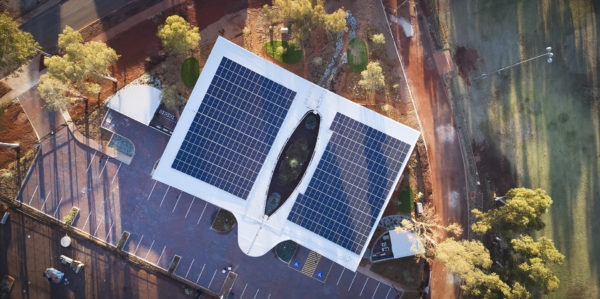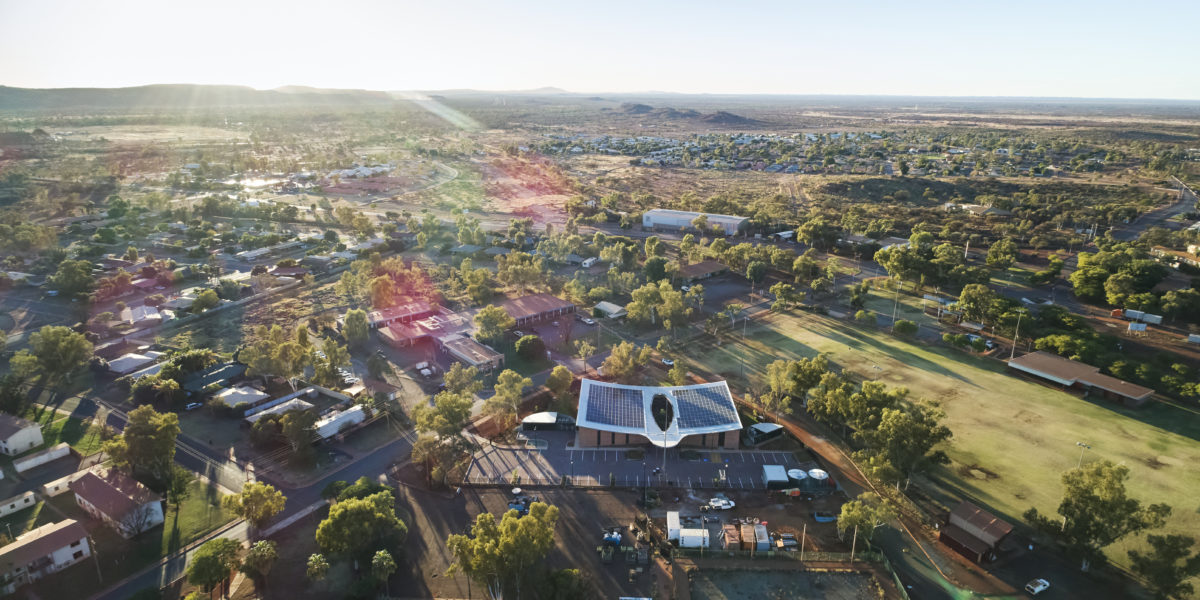It’s a big rooftop, spanning a variety of allied health services — maternal and children’s health care, physio, dental care and dialysis among them — for the Indigenous community of Newman in The Pilbara, and incorporating the head office of the Puntukurnu Aboriginal Medical Service. Officially opened on Friday, the building is powered by 150 kW of rooftop PV, which will provide at least 80% of its electricity needs pretty much every day, even without battery storage.
The sun in Newman, 15 kilometres north of the Tropic of Capricorn, and 1,200 kilometres north of Perth, is relentless — it only rains on an average of 30 days a year; so David Kaunitz of Kaunitz Yeung Architecture was surprised to calculate that the clinic’s array had increased the postcode’s rooftop solar by as much as 13%.
Newman is principally powered by gas-fired and diesel generation, and Kaunitz tells pv magazine that the decision to load the medical clinic with Risen Energy High Performance Mono PERC 405w modules was made to extend the budget of the facility, to perhaps allow for another practitioner, or additional services.
The last available census by the Australian Bureau of Statistics in 2016 put the population of the Shire of East Pilbara at 10,591, of which 19.6% were Aboriginal. Until the opening of the Kaunitz Yeung-designed clinic, Newman had no dedicated Indigenous health facility. Patients and their supporters often had to travel to Perth for treatment at a cost of $5,000 per person, so the $8 million in Commonwealth funding for the health hub had to be wielded to maximum effect.
Kaunitz Yeung Architecture is renowned in the region for its collaborative design process, and has won coveted international awards for its work on two even more remote PAMS clinics, Punmu and Parnngurr, each of which has a 15 kW array of flexible, glass-free panels — chosen for their resilience to transportation into the outback.
Balancing the funding budget
“It’s an important aspect of the work we do, that there’s no extra funding for the incorporation of art, for the use of local materials, or the inclusion of PV,” Kaunitz says; “It’s a process of guiding clients in prioritising what’s important, and the cost of electricity is a huge issue; power bills can siphon critical funding,”
Kaunitz says new buildings in remote areas are frequently also bigger than whatever they replace, and equipped with air conditioning and other electrically powered technology, such that the agencies running the facility can be blindsided by the accompanying increase in their energy bills. Rooftop PV is one way to balance the ability to have a better, larger, more modern facility with the ability to pay the outgoings.

Robert Frith, Acorn Photography
The rammed-earth Newman building with die-cut metal panel representations of the art works of local artists, and culturally sensitive design of consultation rooms and waiting areas, welcomes community members. Its oval central courtyard and street-facing garden are planted with thousands of endemic plant species.
The success of the architect’s process is confirmed by local elders saying the design of this new health hub is theirs — that they told Kaunitz “what to draw”.
Plugging into energy data
Kaunitz also worked with GENiUX, a “real estate technology solutions company” on the solar implementation here and on the smaller satellite clinics. At Newman, GENiUX has incorporated monitoring of the solar system, and Kaunitz hopes to gather data that will inform the use of solar on future far-northern desert facilities.
At the moment, he says, “there is no data that supports the design of these buildings in remote locations”. There are concerns about how dust will affect the panels, and curiosity as to how much of the facility’s energy the solar can ultimately provide — Kaunitz says it could be 100% on consistently sunny days because the services are only operated during daylight hours. Data logging will enable GENiUX to more definitively answer those questions.
“We think we’ve maximised the PV to demand,” says Kaunitz, which he says in this climate, and in this use case, “is a much more economical way to do it than to start to incorporate batteries, but we’ll see how it goes, and whether the client really wants to push it to zero power bills.”
Newman’s new health hub provides a beautiful demonstration of how light shining through panels of art, and on rooftop PV can be used to serve a community. Does Kaunitz think it will inspire greater uptake of solar in the desert town?
He laughs, “When our client starts bragging about how low their power bills are, I’m sure it will catch on.”
This content is protected by copyright and may not be reused. If you want to cooperate with us and would like to reuse some of our content, please contact: editors@pv-magazine.com.









By submitting this form you agree to pv magazine using your data for the purposes of publishing your comment.
Your personal data will only be disclosed or otherwise transmitted to third parties for the purposes of spam filtering or if this is necessary for technical maintenance of the website. Any other transfer to third parties will not take place unless this is justified on the basis of applicable data protection regulations or if pv magazine is legally obliged to do so.
You may revoke this consent at any time with effect for the future, in which case your personal data will be deleted immediately. Otherwise, your data will be deleted if pv magazine has processed your request or the purpose of data storage is fulfilled.
Further information on data privacy can be found in our Data Protection Policy.